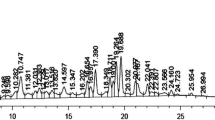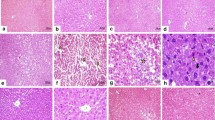Abstract
This study explores the influence of an extract enriched with polyphenol substances obtained from the brown alga Sargassum pallidum and the effect of the Legalon commercial reference preparation on the biochemical indices of the blood at acute hepatic injury induced in rats with carbon tetrachloride (CTC). Administration of S. pallidum extract exhibited a pronounced antioxidant and hepatoprotective effect revealed in reduction of alanine aminotransferase (AlAT) activity in blood plasm, in normalization of superoxide dismutase activity and reduced glutathione contents, of the level of lipid peroxidation, and the liver antiradical activity. We observed recovery of lipid metabolism and elimination of liver fatty infiltration. The S. pallidum extract was as effective as the reference Legalon hepatoprotector and even surpassed it in its ability to restore the phospholipid metabolism. In our opinion, this hepatoprotective effect of S. pallidum extract is associated with the action of polyphenols contained in brown algae, that is, phlorotannins, which are highly active antioxidants and restore the liver metabolic reactions after toxic hepatic injury with CTC.
Similar content being viewed by others
References
Vengerovsky, A.I., Markova, I.V., and Saratikov, A.S., Preclinical study of hepatoprotective agents, Ved. Farmakol. Kom., 1999, no. 2, pp. 99–12.
Goncharenko, M.S. and Latinova, A.M., Method for assessing lipid peroxidation, Lab. Delo, 1985, no. 1, pp. 60–61.
Grishchenko, E.B. and Shchekina, M.I., The role of hepatoprotectors in the treatment of liver diseases, Farmateka, 2014, no. 14, pp. 76–79.
Gusakova, E.A. and Gorodetskaya, I.V., Stress and proteolytic enzymes of lysosomes), Vestn. Vitebsk. Gos. Med. Univ., 2012, vol. 11, no. 4, pp. 15–25.
Novgorodtseva T.P., Endakova E.A., and Yan’kova V.I., Rukovodstvo po metodam issledovaniya parametrov sistemy “Perekisnoe okislenie lipidov antioksidantnaya zashchita” v biologicheskikh zhidkostyakh (A Guide to Methods for Studying the Parameters of the System “Peroxide Oxidation of Lipids—Antioxidant Protection” in Biological Fluids), Vladivostok: Dal’nevost. gos. Univ., 2003.
Sprygin, V.G., Kushnerova, N.F., Fomenko, S.E., et al., The hepatoprotectice properties of an extract from the brown alga Saccharina japonica, Russ. J. Mar. Biol., 2013, vol. 39, no. 1, pp. 65–69.
Titlyanov, E.A. and Titlyanova, T.V., Morskie rasteniya stran Aziatsko-Tikhookeanskogo regiona, ikh ispol’zovanie i kul’tivirovanie (Marine Plants of the Countries of the Asia-Pacific Region, Their Use and Cultivation), Vladivostok: Dal’nauka, 2012.
Amenta, J.S., A rapid chemical method for quantification of lipids separated by thin-layer chromatography, J. Lipid Res., 1964, vol. 5, no. 2, pp. 270–272.
Boll, M., Weber, L.W., Becker, E., and Stamp, H.A., Pathogenesis of carbon tetrachloride-induced hepatocyte injury Bioactivation of CCI4 by cytochrome P450 and effects on lipid homeostasis, Z. Naturforsch. C, 2001, vol. 56, no. 1–2, pp. 111–121.
Cornelius, F., Habeck, M., Kanai, R., et al., General and specific lipid–protein interactions in Na,KATPase, Biochim. Biophys. Acta: Biomembr., 2015, vol. 1848, no. 9, pp. 1729–1743.
Folch, J., Less, M., and Sloane-Stanley, G.H., A simple method for the isolation and purification of total lipides from animal tissues, J. Biol. Chem., 1957, vol. 226, no. 1, pp. 497–509.
Gall, E.A., Lelchat, F., Hupel, M., et al., Extraction and purification of phlorotannins from brown algae, Methods in Molecular Biology, Vol. 1308: Natural Products from Marine Algae, Totowa: Humana, 2015, pp. 131–143.
Kang, K.A., Lee, K.H., Chae, S., et al., Triphlorethol-A from Ecklonia cava protects V79-4 lung fibroblast against hydrogen peroxide induced cell damage, Free Radical Res., 2005, vol. 39, no. 8, pp. 883–892.
Kang, K.A., Zhang, R., Chae, S., et al., Phloroglucinol (1,3,5-trihydroxybenzene) protects against ionizing radiation-induced cell damage through inhibition of oxidative stress in vitro and in vivo, Chem. Biol.-Interact., 2010, vol. 185, no. 3, pp. 215–226.
Michalak, I. and Chojnacka, K., Algae as production systems of bioactive compounds, Eng. Life Sci., 2015, vol. 15, no. 2, pp. 160–176.
Paoletti, F., Aldinucci, D., Mocali, A., and Caparrini, A., A sensitive spectrophotometric method for the determination of superoxide dismutase activity in tissue extracts, Anal. Biochem., 1986, vol. 154, no. 2, pp. 536–541.
Parys, S., Rosenbaum, A., Kehraus, S., et al., Evaluation of quantitative methods for the determination of polyphenols in algal extracts, J. Nat. Prod., 2007, vol. 70, no. 12, pp. 1865–1870.
Ragan, M.A. and Glombitza, K.W., Phlorotannins, brown algal polyphenols, Progr. Phycol. Res., 1986, vol. 4, pp. 129–241.
Raghavendran, H.R.B., Sathivel, A., and Devaki, T., Hepatoprotective nature of seaweed alcoholic extract on acetaminophen induced hepatic oxidative stress, J. Health Sci., 2004, vol. 50, no. 1, pp. 42–46.
Re, R., Pellegrini, N., Proteggente, A., et al., Antioxidant activity applying an improved ABTS radical cation decolorization assay, Free Radic. Biol. Med., 1999, vol. 26, no. 9–10, pp. 1231–1237.
Rouser, G., Kritchevsky, G., and Yamamoto, A., Column chromatographic and associated procedures for separation and determination of phosphatides and glycolipids, Lipid Chromatographic Analysls, Marinetti, D.V., Ed., New York: Marcel Dekker, 1967, vol. l, pp. 99–162.
Sánchez-Camargo, A.d.P., Montero, L., Stiger-Pouvreau, V., et al., Considerations on the use of enzymeassisted extraction in combination with pressurized liquids to recover bioactive compounds from algae, Food Chem., 2016, vol. 192, pp. 67–74.
Sanzgiri, U.Y., Srivatsan, V., Muralidhara, S., et al., Uptake, distribution, and elimination of carbon tetrachloride in rat tissues following inhalation and ingestion exposures, Toxicol. Appl. Pharmacol., 1997, vol. 143, no. 1, pp. 120–129.
Shibata, T., Nagayama, K., Tanaka, R., et al., Inhibitory effects of brown algal phlorotannins on secretory phospholipase A(2)s, lipoxygenases and cyclooxygenases, J. Appl. Phycol., 2003, vol. 15, no. 1, pp. 61–66.
Svetashev, V.I. and Vaskovsky, V.E., A simplified technique for thin-layer microchromatography of lipids, J. Chromatogr., 1972, vol. 67, no. 2, pp. 376–378.
Vaskovsky, V.E., Kostetsky, E.Y., and Vasendin, I.M., A universal reagent for phospholid analyses, J. Chromatogr., 1975, vol. 114, no. 1, pp. 129–141.
Weber, L.W.D., Boll, M., and Stampfl, A., Hepatotoxicity and mechanism of action of haloalkanes: carbon tetrachloride as a toxicological model, Crit. Rev. Toxicol., 2003, vol. 33, no. 2, pp. 105–136.
Wong, C.K., Ooi, V.E.C., and Ang, P.O., Protective effects of seaweeds against liver injury caused by carbon tetrachloride in rats, Chemosphere, 2000, vol. 41, no. 1–2, pp. 173–176.
Wong, C.K., Ooi, V.E.C., and Ang, P.O., Hepatoprotective effect of seaweeds' methanol extract against carbon tetrachloride-induced poisoning in rats, Hydrobiologia, 2004, vol. 512, nos. 1–3, pp. 267–270.
Yamashita, H., Goto, M., Matsui-Yuasa, I., and Kojima-Yuasa, A., Ecklonia cava polyphenol has a protective effect against ethanol-induced liver injury in a cyclic AMP-dependent manner, Mar. Drugs, 2015, vol. 13, no. 6, pp. 3877–3891.
Ye, H., Zhou, C.H., Sun, Y., et al., Antioxidant activities in vitro of ethanol extract from brown seaweed Sargassum pallidum, Eur. Food Res. Technol., 2009, vol. 230, no. 1, pp. 101–109.
Yende, S.R., Harle, U.N., and Chaugule, B.B., Therapeutic potential and health benefits of Sargassum species, Pharmacogn. Rev., 2014, vol. 8, no. 15, pp. 1–7.
Author information
Authors and Affiliations
Corresponding author
Additional information
Original Russian Text © V.G. Sprygin, N.F. Kushnerova, S.E. Fomenko, E.S. Drugova, L.N. Lesnikova, V.Yu. Merzlyakov, T.V. Momot, 2017, published in Biologiya Morya.
Rights and permissions
About this article
Cite this article
Sprygin, V.G., Kushnerova, N.F., Fomenko, S.E. et al. The Influence of an Extract from the Marine Brown Alga Sargassum pallidum on the Metabolic Reactions in the Liver under Experimental Toxic Hepatitis. Russ J Mar Biol 43, 479–484 (2017). https://doi.org/10.1134/S1063074017060098
Received:
Published:
Issue Date:
DOI: https://doi.org/10.1134/S1063074017060098




